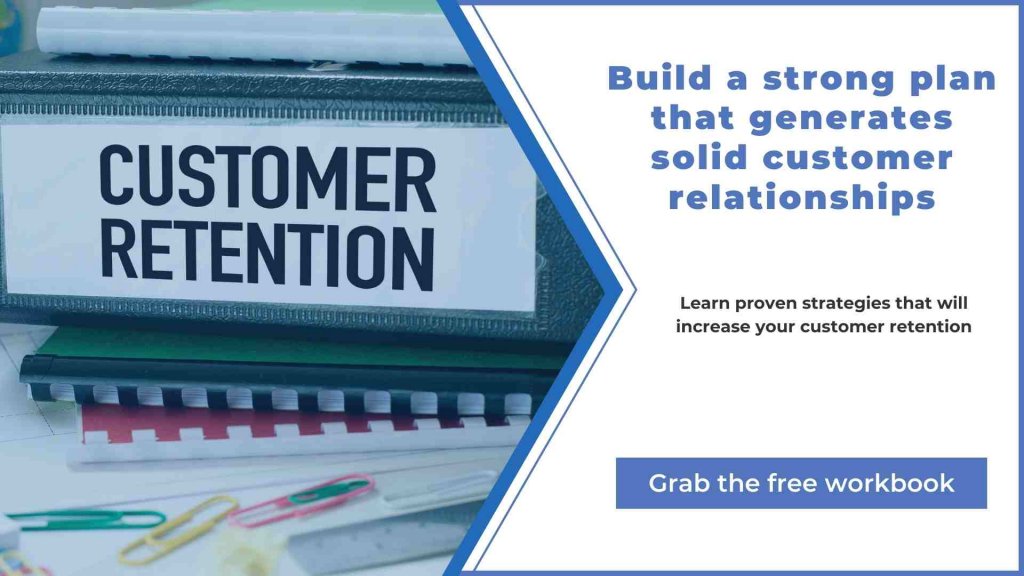VIEW BY TOPIC
- Finding Customers
- Business Systems
- Managing Employees
- Leadership
- Managing Money
Related Posts
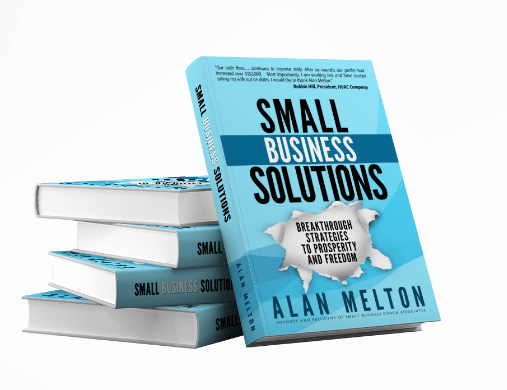
Ready to Grow Your Business Fast?
Here’s How I Grew Five Businesses, and Eventually Sold One to a Fortune 500 Company.

5 Easy Steps to a Killer Customer Success Plan!
What is a customer success plan?
A customer success plan defines customer success and what it looks like, as well as how you can aid customers to achieve that success. By customer success plan, we refer to a roadmap that guides the operations of customer success teams. These customer success plans ensure the right resources are being delivered to the customers to ensure they receive the desired value from consuming your product.
What’s the difference between customer success and customer service?
We must stress out that customer success isn’t the same as customer service. You’ll even see the terms “customer success,” “customer service,” or “customer support” used interchangeably, but they aren’t the same thing.
Customer success encompasses a proactive approach to making your customers successful. This is sometimes also referred to as “customer happiness.” By customer service, we refer to a more reactive approach to ensuring customer satisfaction. Customer service or customer support handles unanticipated issues or needs from customers. By being reactive, we mean the customer usually initiates customer service to interact with the service or support desk. Also, we can say that customer service is a tool to put out the fire, while customer success deals with the long-term experience that your customers have with your product.
Why should you create a customer success plan?
Customer success plans are essential, and you should have them for your business. Some benefits of customer success plans include increased trust and transparency with customers, alignment of customer objectives, reduce churn and increase recurring.
Here are the benefits created by outcome success plans:
Success plans reveal a precise alignment to customer objectives
Success plans enable everyone in the company, including the customer, to be able to view pertinent information on client goals and the overall progress of the company in attaining those goals. This allows a clear view of objectives, and from this central interface, work assignments can be given to the appropriate parties – be it the internal or customer team – ensuring that everyone is aligned to customer objectives and is doing their part to help the customer reach their goals.
Success plans help to identify recyclable processes for reliable customer outcomes
When you work from a template of actions, it is a great way to produce consistency and achieve desired outcomes. Such a template of actions can be fine tuned as you set up and use success plans. Improvisations in company actions may sometimes lead to unexpected results, and you want systems that are proven to be effective and can increase success and overall stability.
Using success plans increase trust and transparency with customers
Success plans expose the progress of the company’s product to the customers. This not only demonstrates the value of the product but also increases the trust customers have in the company, as customers can better assess the company’s methodology to see whether it aligns with their values and beliefs. Such transparency will go a long way to instill confidence and trust in the company’s products and processes, and that will keep a steady customer base for the company and products.
Success plans allow for easier Executive Stakeholder assessment
Success plans, especially when digitally represented, allow those in stakeholder meetings to visually illustrate the degree of progress customer teams ate making with each passing day. Such visualizations would help executive decisions as it points out the areas of progress that need emphasis and aspects that need greater scrutiny and adjustments for greater outcomes.
Success plans help reduce churn
Every company needs to have a steady customer base to succeed. Having high churn rates is not profitable for any business. It creates a situation similar to a leaking bucket where customers leave the businesses even as you’re trying to engage new customers. This offsets the top line customer growth as the customer base is kept either constant or decreases steadily despite efforts by the company to gain new customers.
Success plans help decrease customer cancel flows, making growth much easier as it ensures customers are kept happy as they use company products. With sustained customer satisfaction, customers are less likely to churn, keeping the company on a steady growth path.
Success plans increase the likelihood of upsells and cross-sells
Success plans, by making customers happy and successfully impacting them positively, impact your business as it gives you more success increasing upsell and cross-sell opportunities. Upselling has to do with engaging customers to buy into more feature-rich and more expensive tiers. Cross-selling entails selling additional products to existing users. To be more successful with upselling and cross-selling, you need to make your customers happy and successful with your core product experience. That is the fundamental goal of your customer success plan. Once you’ve done that and achieved good results, you can include tactics in your customer success plan o move your customers towards premium tiers or additional products.
Using success plans increase recurring revenue
Happy customers mean greater revenue. Greater upsells and cross-sells mean greater revenue. Happy customers also increase company revenue by strengthening your brand and giving referrals. This spreads the words of your products without much of your effort, which will boost your customer acquisition trend, and you’d get more inbound inquiries. This goes to make the sales process much easier.
Applying success plans produces consistency of efforts in the customer lifecycle
Using a customer success roadmap ensures you always have the end goal of your customer in mind. This makes sure you don’t wander-off in your efforts towards meeting the customer’s expectations. Your efforts are, thus, kept consistent as you birth consistent results.
Every stage of the customer lifecycle should have its typical customer success goals. Plans help to make sure you’re always taking steps in the right direction through the right resources at the right time. As you apply your success plans, your efforts are tailored and kept consistent, especially on processes that yield pleasant results for the company.
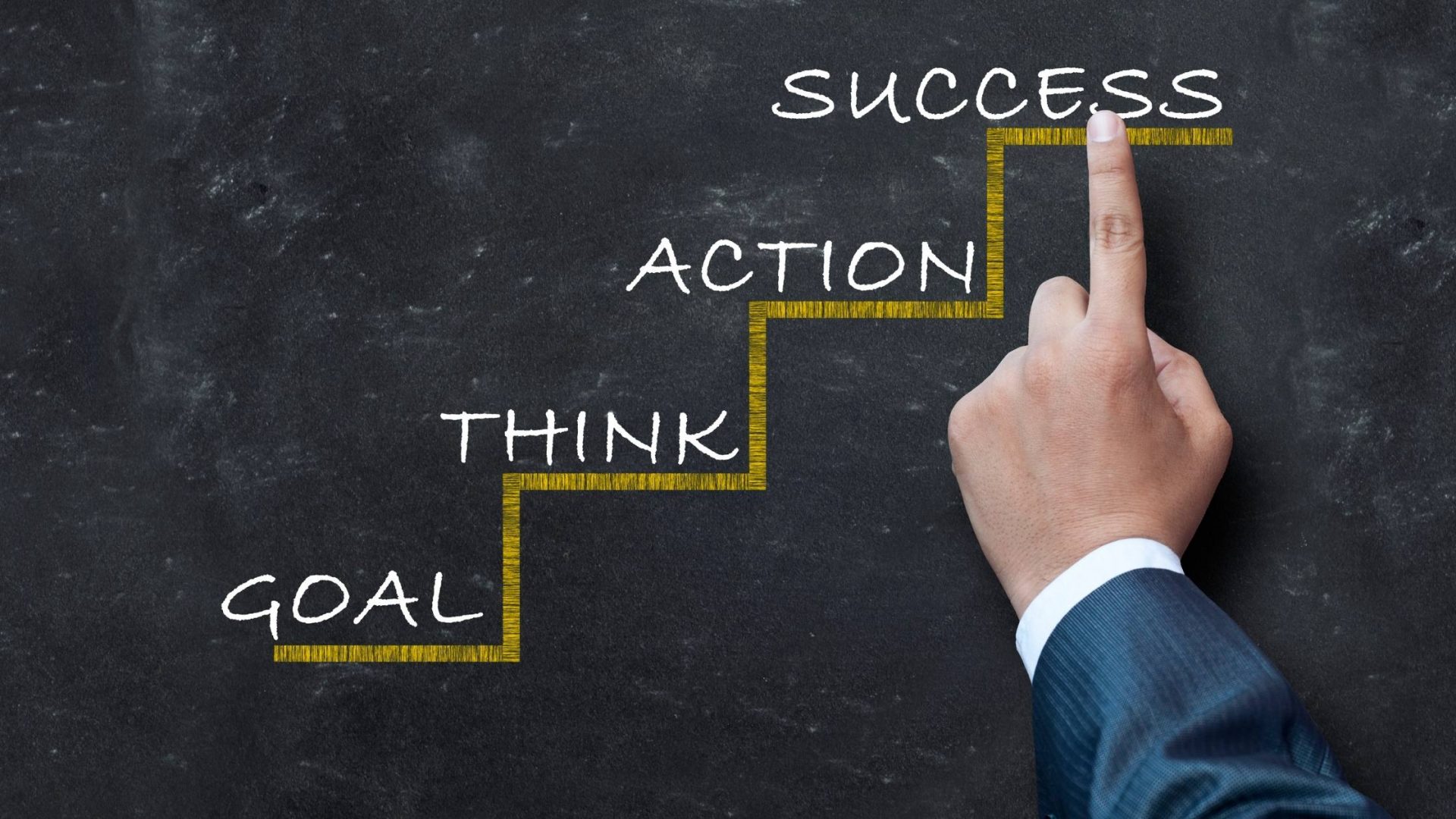
Making use of success plans helps mitigate unpleasant surprises
By using a plan, you can assuredly achieve your end-goals if you tread the right path. And when any unexpected requests come from your customer, you can more accurately measure in advance whether that is achievable or not. If it’s achievable, then you would know exactly what to tweak in your success plan to meet those expectations. This keeps you out of some unpleasant surprises that come as you make unplanned decisions. A success plan keeps your decisions and actions well calculated for success and mitigates any unpleasant surprise actions.
Success plans help to save execution time
The time spent repairing always out beats the time it would indeed have taken to prepare properly, which applies to businesses. The time spent to bail yourself and the company out of a crossroad is always more than when you would have taken to prepare for such situations. Planning takes out the guesswork from the equation and produces greater efficiency as you tackle firefighting issues. Planning covers any unprecedented situations and keeps you on the offensive for any possible outcome. That saves time in executing strategies when such situations do come up, as you know exactly what to do from your plan. Success plans, thus, help to save execution time.
Success plans create better outcomes with lower operational costs
Operation time and efforts reduce considerably through the use of a customer success plan. You don’t have to spend time and money figuring and guessing what you should do next when you reach a milestone. Your customer success team would always be prepared to move on to the next stage in the customer journey as they simply follow up on the established customer success plan. This greatly reduces operational costs while still maintaining efficient and productive outcomes.
Success Plan Prerequisites
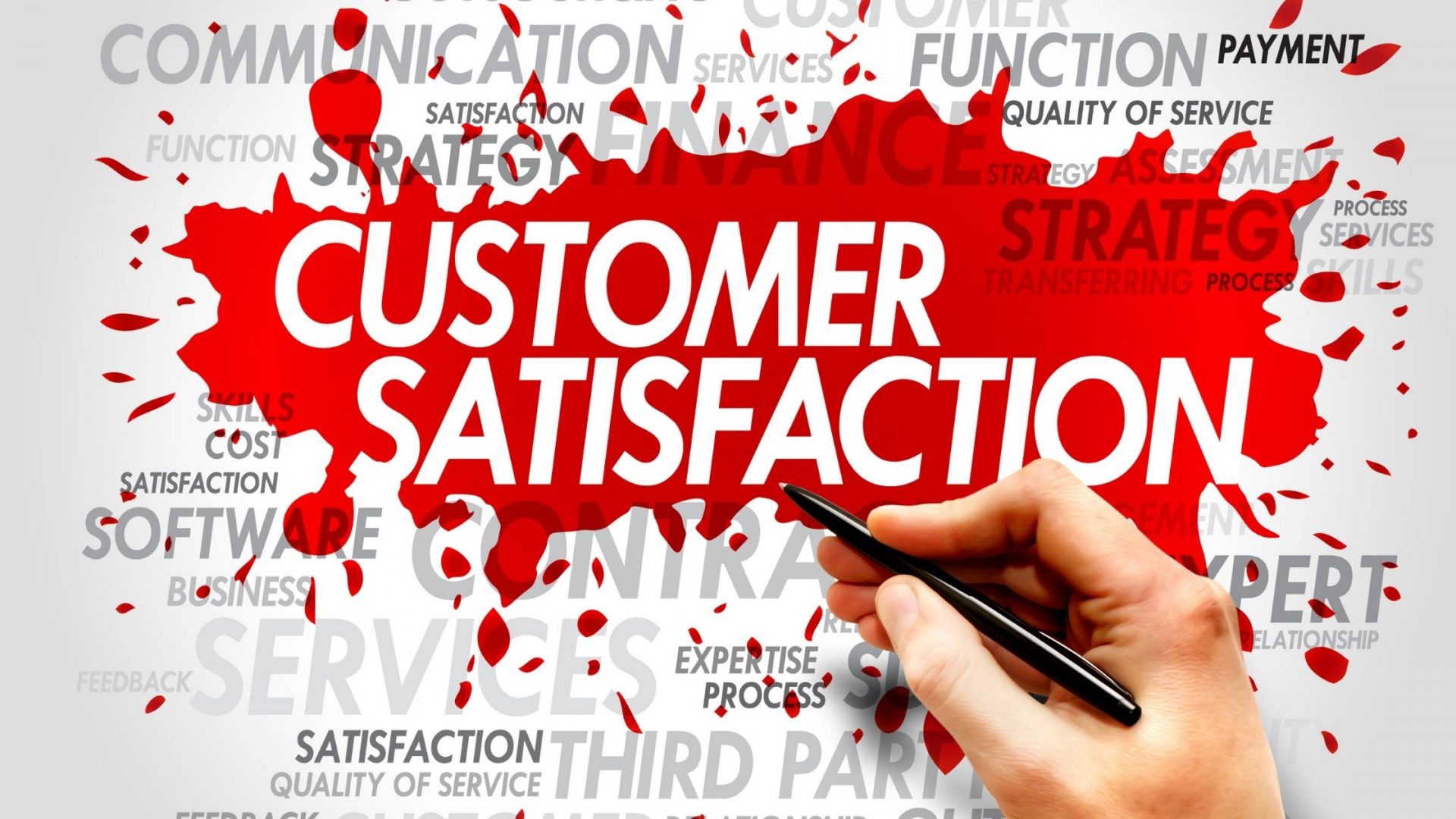
Understand the Customer’s Motivation
Before you can develop a success plan, you must understand what drives the customer’s usage of your product. This goes beyond the features they are interested in and extends to the business value you provide. This assessment should also include any potential risks or barriers, key stakeholders, and any other relevant information concerning their desire to use your products.
Prepare discovery questions to discuss with the customer to collect any missing information
When necessary, you may need to physically engage the customers with questions when you need more specific information. This could be in the form of interviews, questionnaires, polls, etc., to collect any additional information useful for success planning and developing a good relationship with the customers.
Talk with the stakeholders
When it comes to the business objectives that the customer is pursuing, all stakeholders should agree, as well as on which products and services will help them reach that goal. It is good practice to keep the scope focused on 1-3 objectives. As you close out objectives, you can restart the process to define and add new ones to your list.
You can also use questionnaires to validate your existing knowledge of the customer’s business outcomes and pain points, as well as to learn about business outcomes you don’t know yet.
For each business objective, review with the customer:
- What is the objective’s priority relative to the others objectives?
- Which stakeholders will benefit from this objective?
- How should we prioritize efforts for your teams?
- Are there any quick wins?
- Key contributions & responsibilities of everyone involved
- Are there deadlines for individual steps or overall completion?
Understand success plans are living documents
Sharing progress with everyone involved as time goes on is important. You should keep the Sales team and the customer up to date on where the success plan objectives and tasks stand so that they can continue working on new tasks. They’d also be able to share the progress with anyone else they think should be aware.
Change in a customer’s business and strategies is normal, so the value that they need from you will change with that. To stay up to date, you should keep public your success plan so that the customers can always have a fresh understanding of their needs. You can email a report to the customer regularly (maybe once a month or some other frequency), citing the objectives and inviting them to reply if they’re out of date.
It’s also a good practice to set aside key times when you interact with a customer that would be good opportunities to review and refresh the success plan. This could be when discussing business goals feels appropriate, with the right stakeholders at the table. A good example of such a time would be at key hand-offs between teams, EBRs, or executive check-ins.
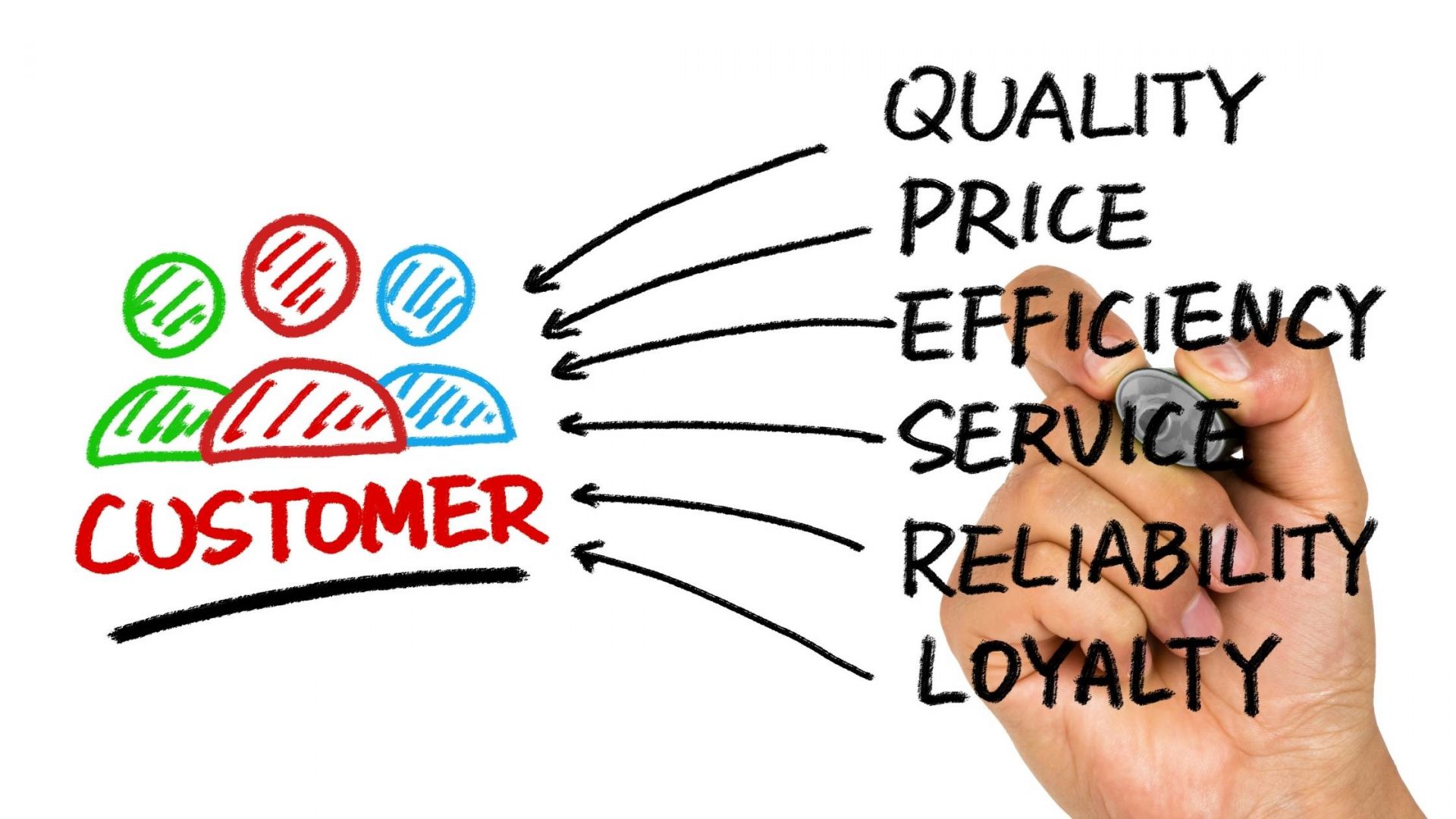
5 Simple Steps to Creating Your Customer Success Plan
When it comes to creating a success plan, here are some quick steps that can help guide the process to ensure for your company.
Step 1: Define Expectations
You must consciously aid your customers to express their expectations from your product right from the beginning. The customer onboarding phase is a great time to discover these expectations. You could also make use of strategic discussions to unravel their expectations of your product.
Next up, you must quickly demarcate which expectations are achievable and not as soon as possible. Concomitantly, you must synthesize your expectations from the customers, e.g., quick adoption, brand advocacy, etc.
This is a logical first step. You simply can’t plan if you don’t know what your end-goal and milestones are. You must establish why your customers have subscribed to your product. What are their motivations for choosing your product? What are their pain points? What do they aim to achieve? And what does success mean for them? You must know this from the start. Never assume that you know your customer’s expectations– that’s a rookie mistake! Don’t be afraid to let them (and other stakeholders) tell you. And when they aren’t so sure of their expectations, you can always define them together.
Having established what each customer expects from your product, you can begin to segment customers and create a user persona. With these subgroups in place, you would be able to create success plans best suited to meet the specificities of each group. This stems from the notion that not all customers are the same, and they’re likely to churn of you fail to meet their needs individually. Specifically tailored success plans would be best suited to achieve this result.
Once you have defined expectations/ goals and segmented your customers, you can prioritize and address each one of them, moving ion from expectations to actual action.
Step 2: Go from expectations to action
Create processes to meet goals. Expectations are the goals you would be directing your customer success plan towards. While expectations are the “what,” you need to lay out the “how.” You must establish clear, attainable steps that you would be following towards meeting those goals. This entails figuring out what processes to put in place to ensure you meet and even exceed the customers’ expectations.
This step moves you from a theoretical framework to a practical application of your plan. No matter how exciting expectations are, they’d never materialize without an actionable step by step guide to achieving them.
Step 3: Measuring the deliverables (based on the goals)
While customer goals and expectations can vary, they would always reflect improving the business. You should also note that each expectation has a metric that can be measured and followed up to see whether it is being attained or not. This would help you monitor customer health and identify red flags that may need to be addressed.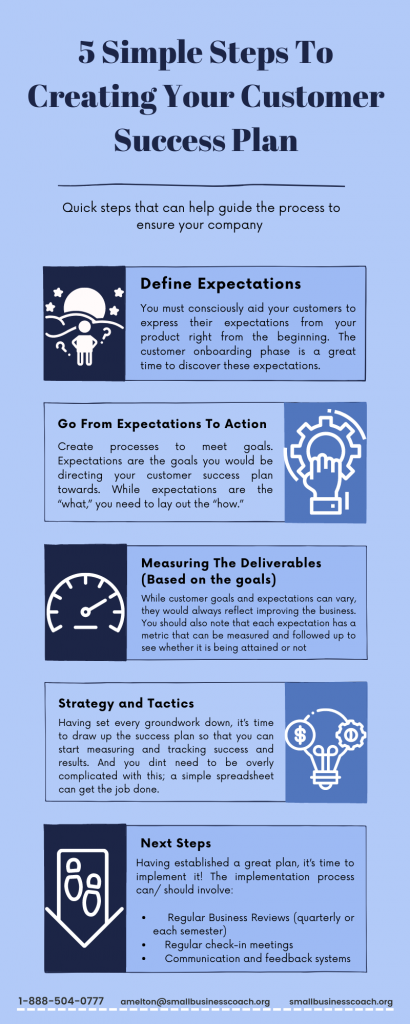
It is also important to note that for every expectation of the customer, there should be a specific individual responsible for that expectation. For example, if your customer expects optimal value from your product, then you should have someone assigned who’d measure whether the customer is getting the best value from your product. Such measurements could take the form of quarterly business reviews.
Having measurable and actionable objectives is important. If you have a company objective to maximizes customer value intruder to achieve negative churn in the business, for example, then a measurable and actionable way to achieve this could be to ensure that averagely 50% of customers who renew their commitment to the company over six months have an agreed upon and well-discussed success plan!
Step 4: Strategy and tactics
Having set every groundwork down, it’s time to draw up the success plan so that you can start measuring and tracking success and results. And you dint need to be overly complicated with this; a simple spreadsheet can get the job done.
Having established the detailed plan, you must consider the following:
- Define your timelines and stick to them
- Make sure responsibilities are assigned to the relevant individuals
- Be flexible enough, but always stick to the plan
Use metrics to measure the progress
To measure the progress of each point of the customer success plan, make use of measurable metrics. You should, therefore, have a predefined metric for each stage of the success plan to help you determine the efficacy of your processes.

Assign employees and schedules for each stage
To ensure the successful execution of the success plan, you should have a person responsible for execution at each stage of the success plan. They should ensure the goal of their respective stage is closely monitor and met satisfactorily. They should also measure the data for their respective stage and cross-reference with the predefined ideal metrics.
Schedules for stages of the success plan must also be followed to track the progress of tasks accurately. Any lag in executing a task on the success plan should be appropriately reported to the right quarters for corrective action to be taken.
You may need to go the route of using success plan templates to ensure you cover all aspects of planning and execution with the right steps.
Step 5: Next Steps
Having established a great plan, it’s time to implement it! The implementation process can/ should involve:
- Regular Business Reviews (quarterly or each semester)
- Regular check-in meetings
- Communication and feedback systems
You can also use customer success platforms and digital tools to keep you on track with your success plan.
A few mistakes to avoid when creating and implementing a success plan
It is entirely normal to ace challenges while executing a plan, which isn’t different from success plans. While you can’t always address all the challenges that come with developing an implementing a success plan, there are some key mistakes you can avoid to ensure your success plan follows a less hurdled development and implementation.
Not considering customer’s inputs into the success plan
No matter how thorough and fail-proof you think your success plan is, it would never really get the results you intend if you forgot or neglected the customers’ input into it. The first step to setting up a success plan is considering customer goals. You shouldn’t just assume their expectations. Consider customer reviews and expectations into your success plan if you intend it to succeed.
Don’t be too ambitious in your success plan
When creating a success plan, don’t over deliver. Ambitious goals may be hard to achieve and end up being a failure. Make sure your set goals are realistic and achievable. You should have achievable goals that aren’t so magnificent to set out lofty objectives you cannot attain.
Using vanity metrics to measure fruition of success plans
Measurement of the attainment of goals of your success plan is important. You must have metrics to measure your progress as you implement your customer success plan. But making use of vanity metrics to measure your efforts is just as bad as not measuring at all. Such metrics can be misguiding and can even give a false sense of achievement. So, be careful when picking out the metrics for measuring the achievement of the success plan.
Lack of improvisation
A plan exists as a set of guidelines to execute when all things are in order and place. But sometimes, when surprises occur, you need to improvise and re-prioritize your actions to get quick solutions to these impromptu situations. A plan is a guide, but there should always be room for improvement and quick improvisations.

To wrap things up
Success plans are important for the progress of the business, as it gives a picture of what success is, with a practical step-wise approach to achieving such success. These plans synthesize the expectations of the customers and executives of the business into an actionable and achievable set of actions towards business success. By steadily following up on your success plan, you can better identify how and when to engage with customers, mitigate chances of churn, and actively (and proactively) work towards achieving the goals and objectives of the business. This keeps your eyes on the prize at all times and sets you on the path to business success. Check out this article about becoming a successful business owner.
















